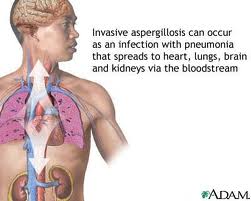Aspergillosis - symptoms and treatment

What is Aspergillosis and Definition
Aspergillosis is an opportunistic fungal (yeast) INFECTION that can manifest as PNEUMONIA in people who have HIV/AIDS, are undergoing CHEMOTHERAPY to treat cancer, receive IMMUNOSUPPRESSIVE THERAPY after ORGAN TRANSPLANTATION, or are otherwise IMMUNOCOMPROMISED. Aspergillosis may also occur as an allergic reaction (called allergic bronchopulmonary aspergillosis or ABPA) in people who have ASTHMA or CYSTIC FIBROSIS, causing airway INFLAMMATION and fluid accumulation in the LUNGS. Aspergillus, the infective FUNGUS, is common in the environment, especially in decaying vegetation and in the soil, and in air ventilation ducts in buildings. Hospitals also harbor Aspergillus, so aspergillosis can develop as a nosocomial infection. Occasionally aspergillosis takes the form of an encapsulated ball, called an aspergilloma or a mycetoma, that forms within a pocket of healed SCAR tissue from previous damage to the lung such as may remain from TUBERCULOSIS or SARCOIDOSIS.
Symptoms of Aspergillosis and Diagnostic Path
Symptoms of aspergillosis vary widely and may not appear at all unless the fungus establishes itself within the lungs in a widespread pattern. When symptoms are present they typically include
- HEMOPTYSIS (bleeding from the lungs that appears in the SPUTUM or coughing up BLOOD)
- CHEST PAIN
- FEVER
- COUGH
- rapid or difficult BREATHING (DYSPNEA)
The doctor also may suspect aspergillosis in a person who has been receiving treatment for an apparent bacterial infection without any improvement in symptoms. The diagnostic path typically begins with a chest X-RAY, which shows whether there are infiltrates or obstructions in the lungs. COMPUTED TOMOGRAPHY (CT) SCAN often can provide more detailed visualization of lung structures and anomalies. Though imaging results are not conclusive, they provide leading clues to suggest or rule out aspergillosis. Because aspergillosis spores are so common in the environment, sputum cultures are not usually helpful in making the diagnosis as nearly everyone’s sputum is likely to contain some Aspergillus. BRONCHOALVEOLAR LAVAGE, in which the pulmonologist rinses cell samples from the walls of the bronchi during BRONCHOSCOPY, or biopsy to obtain tissue samples, may provide more accurate culture results. The individual’s health history also plays a key role in making the diagnosis.
Aspergillosis Treatment Options and Outlook
Invasive aspergillosis is life-threatening and requires treatment with intravenous (IV) ANTIFUNGAL MEDICATIONS such as amphotericin B, itraconazole, or voriconazole. Recovery depends on the IMMUNE SYSTEM’s ability to rally against the infection. In people who are immunocompromised, the challenge may be overwhelming. In such situations aspergillosis can have serious and even fatal consequences. However, most people fully recover with appropriate treatment. Aspergillomas may require surgery to remove them when they cause bleeding (evident as hemoptysis), pain, or difficulty breathing. CORTICOSTEROID MEDICATIONS such as prednisone are usually effective in relieving the symptoms of ABPA, which is an immune reaction to the presence of Aspergillus, common in people who have asthma, rather than an invasive infection with the fungus.
Risk Factors and Preventive Measures
People who are taking immunosuppressive therapy, such as after organ transplantation, or who are immunocompromised are vulnerable to invasive aspergillosis because their immune systems cannot fend off this ordinarily innocuous fungus. Aspergillosis is also a risk for people who have HIV/AIDS. Though there are no measures for preventing aspergillosis, those who are susceptible to this fungal infection can minimize the severity of disease by seeking medical diagnosis and treatment at the earliest indication of disease.
See also BRONCHIECTASIS; NEUTROPENIA.
Open discussion on the topic Aspergillosis - symptoms and treatment
Similar interests
- Nuovi Casino
- Casinos Not On Gamstop
- UK Casinos Not On Gamstop
- Casinos Not On Gamstop
- UK Casinos Not On Gamstop
- Casino Non Aams Italia
- Slot Sites Not On Gamstop
- Meilleur Casino En Ligne
- Non Gamstop Casino Sites UK
- Meilleur Casino En Ligne
- Casino En Ligne France
- Best Non Gamstop Casinos
- Casinos Not On Gamstop
- UK Casino Not On Gamstop
- Casinos Not Signed Up To Gamstop
- Best Slot Sites UK
- Non Gamstop Casino Sites UK
- Online Casinos Nederland
- Online Casinos Nederland
- Casinos Not On Gamstop
- Best New Uk Casinos Not On Gamstop
- Casino Non Aams
- Non Gamstop Casinos UK
- Migliori Siti Casino Non Aams
- Bitcoin Casinos
- Sites De Paris Sportifs Belgique
- Bookmaker Non Aams
- Casino En Ligne